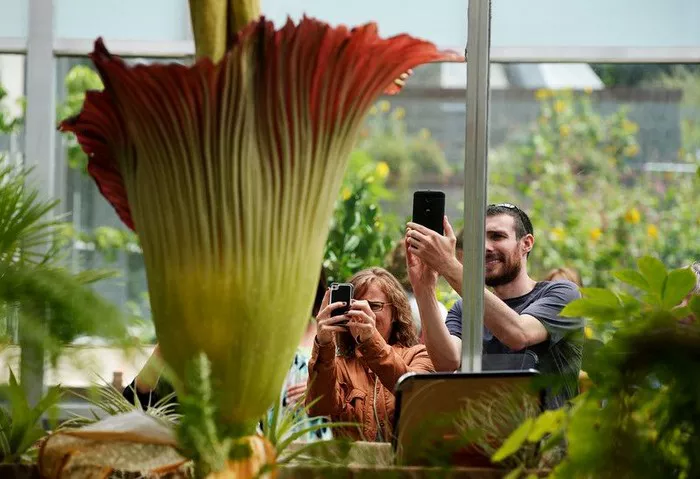Last month, a rare event drew crowds to the California Academy of Sciences in San Francisco. Visitors flocked to witness and experience an extraordinary botanical phenomenon: the blooming of an endangered tropical flower known for its intense odor, reminiscent of rotting food or sweaty socks.
The flower in question, an Amorphophallus titanium, commonly referred to as a corpse flower, blooms for a fleeting period of one to three days once every seven to 10 years. During this short window, it emits a potent scent, compellingly mimicking the odor of a decaying carcass to attract pollinators such as flies.
Lauren Greig, a horticulturist at the California Academy of Sciences, explained the flower’s strategy, stating, “It’s kind of imitating the smell of … a dead carcass to … get all the flies to come and interact with it, pick up pollen, and then take that pollen to another flower that it might investigate due to its smell.”
Named Mirage, this particular corpse flower, donated to the California Academy of Sciences in 2017, had its inaugural bloom, captivating visitors since it was housed in the museum’s rainforest exhibit in 2020.
Among those eager to experience the unique olfactory sensation was Bri Lister, a San Francisco resident, who patiently waited in line for about an hour. Lister described the fragrance as a mix of sweaty socks and gym clothes, thankfully not reaching the extent of full-on rotting meat, yet undeniably pungent.
Monica Becker, another visitor, took her child out of school to witness the rare event firsthand after following the flower’s progress on the academy’s live stream. “When we heard it bloomed, we were like, ‘We got it, we got to go, first thing in the morning when they open.’ So here we are,” Becker remarked.
Originating from the Indonesian island of Sumatra, the Amorphophallus titanium faces the threat of extinction, with fewer than 1,000 individual plants remaining in the wild, as listed by the International Union for Conservation of Nature.
The corpse flower belongs to a group of carrion flowers, which emit foul odors akin to rotting meat to attract pollinators. Among them is the stinking corpse lily (Rafflesia arnoldii), native to Sumatra, known for its massive size and distinct appearance.
Another member of this botanical family is the stinking root parasite (Hydnora africana), thriving in the deserts of southern Africa. Concealed underground, its reddish-pink flowers emit an odor reminiscent of feces, luring beetles for pollination.
In western North America, the western skunk cabbage (Lysichiton americanus) shares a similar strategy, emitting a putrid scent upon blooming to attract flies and beetles. Bears are known to consume its roots for their laxative properties upon awakening from hibernation.
The allure of these malodorous blooms serves as a reminder of nature’s intriguing and often peculiar adaptations, captivating enthusiasts and scientists alike.


